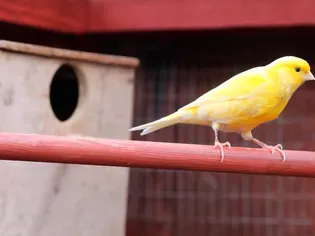How to Care for Hyacinth Macaws (Blue Parrots)
Updated on 05/26/24

Journey into the Azure Embrace: A Comprehensive Guide to Caring for Blue Parrots
In the tapestry of avian wonders, the Hyacinth Macaw stands out as a beacon of cerulean brilliance. Its striking blue plumage, gentle nature, and remarkable intelligence have captivated bird enthusiasts worldwide. If you've been graced with the opportunity to share your life with one of these majestic parrots, congratulations! You've embarked on an extraordinary adventure filled with joy, companionship, and a profound responsibility for their well-being.
To ensure your Hyacinth Macaw thrives in your care, it's essential to equip yourself with comprehensive knowledge of its specific needs. In this exhaustive guide, we delve into every facet of Hyacinth Macaw care, from nutrition and housing to socialization and enrichment. Join us on this educational journey and discover the secrets to nurturing a long-lived and fulfilling relationship with your azure companion.
Understanding the Hyacinth Macaw
* Taxonomy and Origins: Hyacinth Macaws belong to the species Anodorhynchus hyacinthinus, native to the Pantanal and forested regions of central and eastern South America.
* Physical Characteristics: These parrots are renowned for their stunning cobalt-blue plumage, which contrasts beautifully with their bright yellow eye-rings. Their massive hooked beaks and long tails contribute to their impressive size.
* Behavior and Temperament: Hyacinth Macaws are generally gentle and docile, forming strong bonds with their caregivers. They are known for their playful and inquisitive nature, but can also be prone to occasional mood swings.
Creating an Ideal Habitat
* Cage and Aviary: Hyacinth Macaws require spacious living accommodations. A cage measuring at least 6 feet wide, 6 feet deep, and 8 feet tall is recommended. An aviary is the optimal choice, providing ample space for flight and exercise.
* Perches and Toys: Natural wood perches of varying diameters promote foot health and prevent boredom. Offer a variety of toys, such as shreddable paper, foraging puzzles, and interactive toys, to stimulate their intelligence and provide enrichment.
* Temperature and Humidity: Hyacinth Macaws prefer warm, humid environments. Maintain a temperature of around 65-85°F (18-29°C) with a relative humidity of 50-70%.
Nutrition for Optimal Health
* Diet and Supplements: A varied and balanced diet is crucial for Hyacinth Macaws. Their primary food should be high-quality parrot pellets, supplemented with fresh fruits, vegetables, and nuts. Ensure they always have access to fresh water.
* Vitamins and Minerals: Calcium, vitamin A, and vitamin D are essential nutrients for bone health and overall well-being. Consult with an avian veterinarian to determine appropriate supplementation.
* Avoid Toxic Foods: Certain foods are toxic to parrots, including avocado, fruit pits, and chocolate. Research thoroughly and avoid any potential hazards.
Health and Well-being
* Regular Veterinary Care: Routine check-ups and vaccinations are vital for early detection and treatment of health issues.
* Feather Plucking: Feather plucking can be a sign of stress or underlying health conditions. Consult with your veterinarian to identify the cause and develop a treatment plan.
* Fungal and Bacterial Infections: Keep your Hyacinth Macaw's environment clean and sanitized to prevent fungal and bacterial infections.
Socialization and Enrichment
* Bonding and Trust: Hyacinth Macaws thrive on interaction and companionship. Dedicate ample time to bonding with your parrot through play, vocalization, and grooming.
* Mental Stimulation: Provide plenty of toys and puzzles to keep your bird mentally stimulated and prevent boredom. Encourage foraging and problem-solving behaviors.
* Flight and Exercise: Regular flight and exercise are essential for Hyacinth Macaws. Allow them to fly in a secure aviary or supervised outdoor environment.
Training and Behavioral Management
* Positive Reinforcement: Train your Hyacinth Macaw using positive reinforcement techniques, such as clicker training. Reward desired behaviors with treats and praise.
* Biting and Aggression: Understanding the triggers for biting and aggression is crucial. Address fear, boredom, or other underlying causes through behavioral modification and environmental enrichment.
* Recall and Free Flight: With proper training, Hyacinth Macaws can be taught to recall and fly freely while maintaining a bond with their caregiver.
Conclusion
Caring for a Hyacinth Macaw is a rewarding yet demanding endeavor. By following the comprehensive guidelines outlined in this guide, you can provide your azure companion with the best possible care, ensuring a long and healthy life filled with love, enrichment, and unwavering companionship. Remember, every interaction and decision you make impacts the well-being of your feathered friend. Embrace the journey, seek knowledge, and create an environment that fosters their physical, mental, and emotional growth.
Explore More Pets

Small Bird Breeds
Gloster Canary: Bird Species Profile

Small Bird Breeds
Java Finch: Bird Species Profile

Small Bird Breeds
Zebra Finch (Chestnut-Eared Finch): Bird Species Profile

Small Bird Breeds
Alexandrine Parakeet: Species Characteristics & Care

Small Bird Breeds
Canary: Bird Species Profile

Small Bird Breeds
Lovebird (Pocket Parrot) Species Profile

Small Bird Breeds
A Guide to Pet Budgie Birds

Small Bird Breeds
Types of Small Parrots
